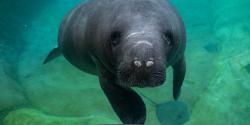Nutrition
Weedy seadragons eat tiny mysid shrimp, sea lice, and larval fish, which are small enough to be sucked in with their long tube-shaped snout.
At the Zoo, they dine almost exclusively on frozen and live mysid shrimp.
Current Range and Historic Range
Weedy sea dragons are only found in the ocean waters off the southern coast of Australia.
Habitat
Weedy seadragons live in places like rocky reefs, seaweed beds, seagrass meadows, and kelp gardens. Their leafy appendages help them camouflage within the seaweed, providing protection from predators. They can handle a range of temperatures that change with the seasons, typically between 55 and 66 degrees Fahrenheit. This species is usually found in waters that are 14 to 26 feet deep, but they have been seen as deep as 164 feet.
Predators and Threats
Seadragons do not have any known predators.
Seahorses and seadragons are facing serious challenges that threaten their survival. Pollution from fertilizers used in farming and industrial activities, along with trash like plastics, is harming the waters where they live. Climate change is altering water temperatures, habitats, and the availability of prey.
Additionally, there is unregulated and illegal trade in seahorses worldwide, often for use in traditional medicine. A major threat to sea life in general is bottom trawling, a fishing method where heavy nets are dragged along the seafloor to catch fish and shrimp. This practice destroys seafloor habitats and catches many unintended species, known as "bycatch." It’s estimated that about 70 million seahorses are caught each year using these non-selective fishing techniques.
Physical Description and Adaptations
Weedy seadragons have a small head with a long, skinny snout, and a delicate neck that leads into a sturdier body. Their prehensile tail can exceed half their total length and is used to grasp onto plants.Their tail, which can be longer than half their body, helps them cling to plants. Males and females are about the same size, but females usually have thicker bodies. They breathe through a small round opening, or gill, and their bodies are covered with hard, bony plates instead of scales.
These seadragons have small, leaf-like appendages that extend from their head, body, and tail. The number, color, and size of these appendages can change based on location and age. Their color can range from orange to reddish-purple, with yellow spots and purplish-blue bars along their sides. Their belly and back fins are almost clear. They have the ability to change colors to camoflauge with their surroundings.
Weedy sea dragons do not have teeth but eat by sucking in their food through their pipe-shaped mouth. A complex arrangement of bones that are moved by muscles to create a strong suction to pull in their food, like drinking through a straw. They eat constantly because they also do not have stomachs.
The outer skin of seadragons is solid, which limits their mobility when trying to escape from predators. They also lack a caudal fin, or tail fin, which limits their swimming abilities. Instead, they swim by quickly moving their belly and back fins, propelling themselves through the water and using their tails to steer. By adjusting the air in their air bladders, they can change their position in the water, allowing them to float vertically or move up and down. Weedy seadragons have fragile swim bladders, which means they can be affected by sudden changes in water pressure or depth. During storms, these changes often lead to unfortunate situations, with many seadragons being found washed up on the shore along with seaweed.
Reproduction
Male sea dragons, similar to sea horses, are responsible for taking care of developing eggs. However, the eggs in weedy sea dragons are incubated on the underside of the male's tail rather than in a brood pouch. In weedy sea dragons, the eggs are not kept in a pouch but are incubated on the underside of the male's tail. When a male is prepared to receive eggs, he shows this by wrinkling the lower part of his tail. The female then places about 250 ruby-colored eggs onto this special area called the brood patch, which has tiny cups made of tissue that provides nourishment to each egg. The eggs start off bright pink when they are laid and then become darker as they grow.
After six to eight weeks of incubation, the eggs hatch over several days. The male slowly releases the baby sea dragons, taking anywhere from a few hours to a couple of days to let go of the entire batch. The tiny sea dragons come out tail-first from their capsules. At first, they have short snouts and do not have the leafy features that adult sea dragons possess. They stay connected to the egg capsule for about two days, feeding off it until their snouts grow longer and they are ready to hunt. Once they're ready, they start eating tiny zooplankton and eventually grow big enough to catch mysid shrimp.
Behaviors
Although typically solitary, seadragons migrate to specific shallow bays where they group together to pair up and mate in late winter. They will also move to deeper waters during winter when food becomes scarce.









